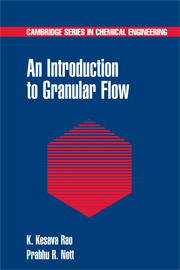Book contents
- Frontmatter
- Contents
- Preface
- Notation
- 1 Introduction
- 2 Theory for Slow Plane Flow
- 3 Flow through Hoppers
- 4 Flow through Wedge-Shaped Bunkers
- 5 Theory for Slow Three-Dimensional Flow
- 6 Flow through Axisymmetric Hoppers and Bunkers
- 7 Theory for Rapid Flow of Smooth, Inelastic Particles
- 8 Analysis of Rapid Flow in Simple Geometries
- 9 Theory for Rapid Flow of Rough, Inelastic Particles
- 10 Hybrid Theories
- Appendix A Operations with Vectors and Tensors
- Appendix B The Stress Tensor
- Appendix C Hyperbolic Partial Differential Equations of First Order
- Appendix D Jump Balances
- Appendix E Discontinuous Solutions of Hyperbolic Equations
- Appendix F Proof of the Coaxiality Condition
- Appendix G Material Frame Indifference
- Appendix H The Evaluation of Some Integrals
- Appendix I A Brief Introduction to Linear Stability Theory
- Appendix J Pseudo Scalars, Vectors, and Tensors
- Appendix K Answers to Selected Problems
- References
- Index
2 - Theory for Slow Plane Flow
Published online by Cambridge University Press: 19 November 2009
- Frontmatter
- Contents
- Preface
- Notation
- 1 Introduction
- 2 Theory for Slow Plane Flow
- 3 Flow through Hoppers
- 4 Flow through Wedge-Shaped Bunkers
- 5 Theory for Slow Three-Dimensional Flow
- 6 Flow through Axisymmetric Hoppers and Bunkers
- 7 Theory for Rapid Flow of Smooth, Inelastic Particles
- 8 Analysis of Rapid Flow in Simple Geometries
- 9 Theory for Rapid Flow of Rough, Inelastic Particles
- 10 Hybrid Theories
- Appendix A Operations with Vectors and Tensors
- Appendix B The Stress Tensor
- Appendix C Hyperbolic Partial Differential Equations of First Order
- Appendix D Jump Balances
- Appendix E Discontinuous Solutions of Hyperbolic Equations
- Appendix F Proof of the Coaxiality Condition
- Appendix G Material Frame Indifference
- Appendix H The Evaluation of Some Integrals
- Appendix I A Brief Introduction to Linear Stability Theory
- Appendix J Pseudo Scalars, Vectors, and Tensors
- Appendix K Answers to Selected Problems
- References
- Index
Summary
At present there are no constitutive equations that are valid over the entire range of densities and velocities encountered in the storage and handling of granular materials. Most of the available equations fall into one of two regimes: (i) slow flow and (ii) rapid flow. In the slow flow regime, the solids fraction ν is high and forces are exerted across interparticle contacts which last for a long time compared to the contact time in the rapid flow regime. The contacts occur during the sliding and rolling of particles relative to each other. In the rapid flow regime, the solids fraction is low, and momentum is transferred mainly by collisions between particles and by free flight of particles between collisions. Consider the flow of a granular material between two parallel plates. If V is the relative velocity of the plates and H is the gap between them, the stresses are found to be approximately independent of the nominal shear rate γ ≡ V/H in the slow flow regime (small γ and high ν) and to increase strongly with γ in the rapid flow regime (large γ and low ν).
In devices such as hoppers and chutes, both the regimes can occur in different spatial regions, and there can also be transition regions where the nature of the flow changes from one regime to the other. Given a device and a set of operating conditions, it is difficult to determine a priori the type of flow regime that is likely to prevail. However, the following criterion can be used as a very rough guideline (Savage and Hutter, 1989).
- Type
- Chapter
- Information
- An Introduction to Granular Flow , pp. 54 - 115Publisher: Cambridge University PressPrint publication year: 2008



